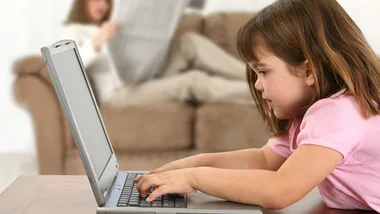A few preventive steps could mean the difference between your child’s life and death, and knowing how to react in an accident will give you with peace of mind, too. Here is our advice on how to cope in eight situations.
1. Choking
Choking is a very common worry, but it’s often very hard to tell whether a child is really choking or not. Royal Life Saving’s medical director Professor John Pearn says that sometimes while eating or drinking your child may start coughing, spluttering and acting upset, but it’s usually just that a tiny amount of food or milk has touched the back of the airway – the coughing is the body’s mechanism to deal with it.
However, if your baby isn’t crying, and is struggling for air, have someone call an ambulance while you carefully remove the object yourself with your finger, or by giving back blows.
“Using the flat base of your hand, give sharp blows just between the shoulder blades, which should be enough to expel air out of a child’s lungs,” says Prof Pearn, who is professor of paediatrics and child health at the Royal Children’s Hospital in Brisbane.
Choking is obviously better avoided, so keep small, swallowable items such as small batteries, buttons and coins away from babies, and don’t let them eat hard foods such as nuts.
2. Allergic shock
It’s unusual for a first allergic reaction to be serious, so if your child does have a severe reaction, you’ll most likely have had a prior warning and will have been advised what to do.
Still, it’s a good idea to be familiar with anaphylaxis (severe allergic reaction); the symptoms of which may include wheezing; sweating; swelling; rashes – especially around the lips or face; diarrhoea or vomiting; floppiness; faint pulse; and loss of consciousness.
Foods such as dairy, eggs, wheat, soya and nuts are typical triggers, as well as latex, drugs and insect stings.
If you suspect an anaphylactic reaction, call an ambulance and lie your baby down with his feet up. Paramedics may give him an injection of adrenaline, and he should recover fully.
3. Bleeding
If you’re sure nothing is embedded in the wound, apply firm pressure to the area of the cut with gauze or tea towels to stem bleeding, and elevate the site of the wound. Then seek medical attention.
“The treatment is pressure – simple, direct pressure with the cleanest thing available; that might be your finger or a handkerchief. Apply firm pressure which should stop the bleeding,” Prof Pearn says.
If there is something embedded in the wound, such as a shard of glass, don’t try to pull it out: you could do more harm and increase blood loss.
4. Meningitis
Sudden and potentially life-threatening, meningitis is one of the most feared diseases. Simply, it’s an inflammation of the membranes that surround and protect the brain and spinal cord.
It’s essential you’re aware of the symptoms. These include feverishness; cold hands and feet; a stiff neck; an arched back; drowsiness; pale blotchy skin; and possibly a distinctive rash that doesn’t fade under the pressure of a glass.
Trust your instincts, and take your child to hospital or your doctor if you’re in any doubt
5. Immunisation
Keeping your child’s immunisations up to date is the most effective thing you can do to protect him from life-threatening illnesses. There’s no evidence that the vaccine for measles, mumps and rubella has any links with autism or diseases, and although some minor adverse reactions to the jabs – like sore arms, redness, irritability and mild temperatures – are possible, more serious side effects, such as allergic reactions, are extremely rare.
6. Safety away from home
It’s vital you have consider safety issues even when the kids are being looked after by others, such as carers or grandparents. Help them be aware of potential safety traps, such as pools, chemicals, driveways and medications.
Prof Pearn says there’s also danger when families are travelling and away from their usual routines: “Travel is a time of particular risk for children – we know that falls, lacerations and, tragically, drowning and near-drowning accidents tend to occur within a few hours of arriving (at a holiday destination).”
7. Dehydration
This can happen during very hot weather, in feverish children, or when they’re suffering from diarrhoea or have been vomiting. Babies are particularly at risk as they can become dehydrated very quickly.
Signs include dark yellow urine; fewer than half a dozen wet nappies in the previous 24 hours; lethargy or lack of playfulness; a sunken soft spot (fontanelle); and dryness of the mouth.
“Every house should have some rehydration fluid – these come in sachets and are easily made up with tap water,” says Prof Pearn.
8. Burns
The immediate treatment for any type of burn is running the affected area under cold running water for at least 10 minutes. If the burn seems more serious, take your child to hospital immediately.
For burns in the eye, rinse under cold water for at least 10 minutes.
With internal burns, due to accidental swallowing of something poisonous, don’t try to make your infant sick – it may further damage the oesophagal tube. Instead, take him straight to hospital.
Become a first aider
One of the most vital things you can do to keep your baby safe is to do a first aid course. Contact St John Ambulance Australia or Royal Life Saving, to find out more – why not get together with a group of friends to do a course together (group discounts are available and the instructors can come to your home


